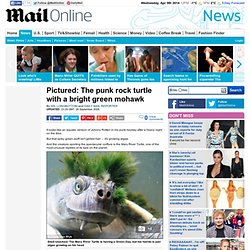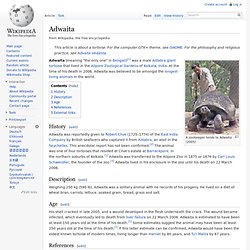

Harriet the tortoise. She was reportedly collected by Charles Darwin during his 1835 visit to the Galápagos Islands as part of his round-the-world survey expedition, transported to England, and then brought to her final home, Australia, by a retiring captain of the Beagle.

However, some doubt was cast on this story by the fact that Darwin had never visited the island that Harriet originally came from. In August 1994, a historian from Mareeba published a letter in the local newspaper about two tortoises he remembered at the Botanic Gardens in 1922 and that the keepers of the time were saying that the tortoises had arrived at the Gardens in 1860 as a donation from John Clements Wickham, who was the first lieutenant (and later captain) of HMS Beagle under Fitzroy during the voyage of the Beagle in 1835. Wickham actually brought three tortoises (named Tom, Dick and Harry) to Australia when he arrived after retiring from the Royal Navy in 1841; these lived at Newstead House from 1841 to 1860. A Wise-Looking Tortoise.
Punk Rock Turtle with a Bright Green Mohawk. By Wil Longbottom and Daily Mail Reporter Updated: 23:29 GMT, 26 September 2008 It looks like an aquatic version of Johnny Rotten in his punk heyday after a heavy night on the tiles.

But that spiky green quiff isn't gelled hair - it's growing algae. And the creature sporting the spectacular coiffure is the Mary River Turtle, one of the most unusual reptiles of its type on the planet. Shell shocked: The Mary River Turtle is having a Green Day, but his hairdo is just algae growing on his head The Mary River Turtle has become a popular figure with Australian environmentalists who say the endangered creature is being further threatened by Queensland State Government's plans to build a dam on the river. It is one of the more unusual species of turtles as it breathes through lung-like structures in its tail and needs shallow water to survive. It was described formally by scientists only in 1994 and little is known about it. A Hippo and Tortoise Tale. Turtle Shell Covered in Moss. Adwaita. A zookeeper tends to Adwaita (2005) Adwaita (meaning "the only one" in Bengali)[1] was a male Aldabra giant tortoise that lived in the Alipore Zoological Gardens of Kolkata, India.

At the time of his death in 2006, Adwaita was believed to be amongst the longest-living animals in the world. History[edit] Adwaita was reportedly given to Robert Clive (1725–1774) of the East India Company by British seafarers who captured it from Aldabra, an atoll in the Seychelles. This anecdotal report has not been confirmed.[2] The animal was one of four tortoises that resided at Clive's estate at Barrackpore, in the northern suburbs of Kolkata.[1] Adwaita was transferred to the Alipore Zoo in 1875 or 1876 by Carl Louis Schwendler, the founder of the zoo.[3] Adwaita lived in his enclosure in the zoo until his death on 22 March 2006.
Description[edit] Weighing 250 kg (590 lb), Adwaita was a solitary animal with no records of his progeny. Age[edit] References[edit] External links[edit]